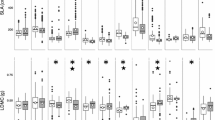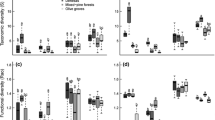Abstract
Assessing the effects of environmental constraints on community structure often relies on methods that consider changes in species functional traits in response to environmental processes. Various indices have been proposed to measure relevant aspects of community trait composition from different viewpoints and perspectives. Among these, the ‘community-weighted mean trait value’ (CWM) and the Rao coefficient have been widely used in ecological research for summarizing different facets of functional composition and diversity. Analyzing changes in functional diversity of bee communities along a post-fire successional gradient in southern Switzerland we show that these two measures may be used to describe two complementary aspects of community structure, such as the mean and the dispersion of functional traits within a given species assemblage. While CWM can be adequately used to summarize shifts in mean trait values within communities due to environmental selection for certain functional traits, the Rao coefficient can be effectively applied to analyze patterns of trait convergence or divergence compared to a random expectation.
Similar content being viewed by others
References
Ackerly D, Cornwell W (2007) A trait-based approach to community assembly: partitioning of species trait values into within- and among-community components. Ecol Lett 10:135–145
Agresti A (2007) An introduction to categorical data analysis. Wiley, New York
Anderson MJ (2001) A new method for non-parametric multivariate analysis of variance. Aust Ecol 26:32–46
Anderson MJ (2006) Distance-based tests for homogeneity of multivariate dispersions. Biometrics 62:245–253
Biesmeijer JC, Roberts SP, Reemer M, Ohlemueller R, Edwards M, Peeters T, Schaffers A, Potts SG, Kleukers R, Thomas CD, Settele J, Kunin WE (2006) Parallel declines in pollinators and insect-pollinated plants in Britain and The Netherlands. Science 313:351–354
Botta-Dukat Z (2005) Rao’s quadratic entropy as a measure of functional diversity based on multiple traits. J Veg Sci 16:533–540
Champely S, Chessel D (2002) Measuring biological diversity using Euclidean metrics. Environ Ecol Stat 9:167–177
Chevenet F, Dolédec S, Chessel D (1994) A fuzzy coding approach for the analysis of ecological data. Freshw Biol 31:295–309
Clarke KR, Warwick RM (2001) A further biodiversity index applicable to species lists: variation in taxonomic distinctness. Mar Ecol Prog Ser 216:265–278
Díaz S, Lavorel S, de Bello F, Quetier F, Grigulis K, Robson TM (2007) Incorporating plant functional diversity effects in ecosystem service assessments. Proc Natl Acad Sci USA 104:20684–20689
Fontaine C, Dajoz I, Meriguet J, Loreau M (2006) Functional diversity of plant–pollinator interaction webs enhances the persistence of plant communities. PLoS Biol 4:1–7
Garnier E, Cortez J, Billes G, Navas ML, Roumet C, Debussche M, Laurent G, Blanchard A, Aubry D, Bellmann A, Neill C, Toussaint JP (2004) Plant functional markers capture ecosystem properties during secondary succession. Ecology 85:2630–2637
Gower JC, Legendre P (1986) Metric and Euclidean properties of dissimilarity coefficients. J Classif 3:5–48
Grime JP (1998) Benefits of plant diversity to ecosystems: immediate, filter and founder effects. J Ecol 86:902–910
Grime JP (2006) Trait convergence and trait divergence in herbaceous plant communities: mechanisms and consequences. J Veg Sci 17:255–260
Hooper DU, Chapin FS III, Ewel JJ, Hector A, Inchausti P, Lavorel S, Lawton JH, Lodge D, Loreau M, Naeem S, Schmid B, Setälä H, Symstad AJ, Vandermeer J, Wardle DA (2005) Effects of biodiversity on ecosystem functioning: a consensus of current knowledge and needs for future research. Ecol Monogr 75:3–35
Izsák J, Papp L (2000) A link between ecological diversity indices and measures of biodiversity. Ecol Model 130:151–156
Laliberté E, Legendre P (2010) A distance-based framework for measuring functional diversity from multiple traits. Ecology 91:299–305
Lavorel S, Grigulis K, McIntyre S, Garden D, Williams N, Dorrough J, Berman S, Quétier F, Thébault A, Bonis A (2008) Assessing functional diversity in the field-methodology matters! Funct Ecol 22:134–147
Lepš J, de Bello F, Lavorel S, Berman S (2006) Quantifying and interpreting functional diversity of natural communities: practical considerations matter. Preslia 78:481–501
Mason NWH, Mouillot D, Lee WG, Wilson JB (2005) Functional richness, functional evenness and functional divergence: the primary components of functional diversity. Oikos 111:112–118
Michener CD (2000) The bees of the world. John Hopkins University Press, Baltimore
Mokany K, Ash J, Roxburgh S (2008) Functional identity is more important than diversity in influencing ecosystem processes in a temperate native grassland. J Ecol 96:884–893
Moretti M, Legg C (2009) Combining plant and animal traits to assess community functional responses to disturbance. Ecography 32:299–309
Moretti M, Conedera M, Duelli P, Edwards PJ (2002) The effect of wildfire on ground-active spiders in deciduous forests on the Swiss southern slopes of the Alps. J Appl Ecol 39:321–336
Moretti M, Obrist KM, Duelli P (2004) Arthropod biodiversity after forest fires: winners and losers in the winter fire regime of the southern Alps. Ecography 27:173–186
Moretti M, Duelli P, Obrist MK (2006) Biodiversity and resilience of arthropod communities after fire disturbance in temperate forests. Oecologia 149:312–327
Moretti M, de Bello F, Roberts SPM, Potts SG (2009) Taxonomical vs. functional responses of bee communities to fire in two contrasting climatic regions. J Anim Ecol 78:98–108
Mouchet MA, Villéger S, Mason NWH, Mouillot D (2010) Functional diversity measures: an overview of their redundancy and their ability to discriminate community assembly rules. Funct Ecol 24:867–876
Norberg J (2004) Biodiversity and ecosystem functioning: a complex adaptive systems approach. Limnol Oceanogr 49:1269–1277
Pavoine S, Dolédec S (2005) The apportionment of quadratic entropy: a useful alternative for partitioning diversity in ecological data. Environ Ecol Stat 12:125–138
Pavoine S, Ollier S, Pontier D (2005) Measuring diversity from dissimilarities with Rao’s quadratic entropy: are any dissimilarities suitable? Theor Popul Biol 67:231–239
Pavoine S, Vallet J, Dufour A-B, Gachet S, Daniel H (2009) On the challenge of treating various types of variables: application for improving the measurement of functional diversity. Oikos 118:391–402
Petchey OL, Gaston KJ (2002) Functional diversity (FD), species richness, and community composition. Ecol Lett 5:402–411
Petchey OL, Gaston KJ (2006) Functional diversity: back to basics and looking forward. Ecol Lett 9:74–758
Petchey OL, Hector A, Gaston KJ (2004) How do different measures of functional diversity perform? Ecology 85:847–857
Petchey OL, Evans KL, Fishburn IS, Gaston KJ (2007) Low functional diversity and no redundancy in British avian assemblages. J Anim Ecol 76:977–985
Pillar VD, Duarte LdS (2010) A framework for metacommunity analysis of phylogenetic structure. Ecol Lett 13:587–596
Pillar VD, Sosinski EE (2003) An improved method for searching plant functional types by numerical analysis. J Veg Sci 14:323–332
Pillar VD, Duarte LdS, Sosinski EE, Joner F (2009) Discriminating trait-convergence and trait-divergence assembly patterns in ecological community gradients. J Veg Sci 20:334–348
Podani J (2005) Multivariate exploratory analysis of ordinal data in ecology: pitfalls, problems and solutions. J Veg Sci 16:497–510
Poos MS, Walker SC, Jackson DA (2009) Functional-diversity indices can be driven by methodological choices and species richness. Ecology 90:341–347
Rao CR (1982) Diversity and dissimilarity coefficients—a unified approach. Theor Popul Biol 21:24–43
Rao CR (2010) Quadratic entropy and analysis of diversity. Sankhya 72:70–80
Reynolds HT (1984) Analysis of nominal data. Sage Publications, Beverly Hills
Ricotta C (2005) Through the jungle of biological diversity. Acta Biotheor 53:29–38
Ricotta C, Moretti M (2010) Assessing the functional turnover of species assemblages with tailored dissimilarity matrices. Oikos 119:1089–1098
Ricotta C, Szeidl L (2006) Towards a unifying approach to diversity measures: bridging the gap between the Shannon entropy and Rao’s quadratic index. Theor Popul Biol 70:237–243
Ricotta C, Szeidl L (2009) Diversity partitioning of Rao’s quadratic entropy. Theor Popul Biol 76:299–302
Schleuter D, Daufresne M, Massol F, Argillier C (2010) A user’s guide to functional diversity indices. Ecol Monogr 80:469–484
Schmera D, Podani J, Erös T (2009) Measuring the contribution of community members to functional diversity. Oikos 118:961–971
Schumacher J, Roscher C (2009) Differential effects of functional traits on aboveground biomass in semi-natural grasslands. Oikos 118:1659–1668
Shimatani K (2001) On the measurement of species diversity incorporating species differences. Oikos 93:135–147
Thompson K, Petchey OL, Askew AP, Dunnett NP, Beckerman AP, Willis AJ (2010) Little evidence for limiting similarity in a long-term study of a roadside plant community. J Ecol 98:480–487
Vandewalle M, de Bello F, Berg MP, Bolger T, Dolédec S, Dubs F, Feld CK, Harrington R, Harrison PA, Lavorel S, da Silva PM, Moretti M, Niemela J, Santos P, Sattler T, Sousa JP, Sykes MT, Vanbergen AJ, Woodcock BA (2010) Functional traits as indicators of biodiversity response to land use changes across ecosystems and organisms. Biodivers Conserv 19:2921–2947
Vile D, Shipley B, Garnier E (2006) Ecosystem productivity relates to species’ potential relative growth rate: a field test and a conceptual framework. Ecol Lett 9:1061–1067
Villéger S, Mason NWH, Mouillot D (2008) New multidimensional functional diversity indices for a multifaceted framework in functional ecology. Ecology 89:2290–2301
Waldbusser GG, Marinelli RL, Whitlatch RB, Visscher PT (2004) The effects of infaunal biodiversity on biogeochemistry of coastal marine sediments. Limnol Oceanogr 49:1482–1492
Walker B, Kinzig A, Langridge J (1999) Plant attribute diversity, resilience, and ecosystem function: the nature and significance of dominant and minor species. Ecosystems 2:95–113
Weiher E, Keddy PA (1999) Relative abundance and evenness patterns along diversity and biomass gradients. Oikos 87:355–361
Westrich P (1989) Die Wildbienen Baden-Württembergs. Ulmer, Stuttgart
Acknowledgments
We thank Andreas Mueller (Swiss Federal Institute of Technology, Zurich) and Stuart P.M. Roberts (University of Reading) for providing bee traits. Insightful comments and suggestions of two anonymous referees on a previous draft of this paper are also warmly acknowledged.
Author information
Authors and Affiliations
Corresponding author
Additional information
Communicated by Roland Brandl.
Rights and permissions
About this article
Cite this article
Ricotta, C., Moretti, M. CWM and Rao’s quadratic diversity: a unified framework for functional ecology. Oecologia 167, 181–188 (2011). https://doi.org/10.1007/s00442-011-1965-5
Received:
Accepted:
Published:
Issue Date:
DOI: https://doi.org/10.1007/s00442-011-1965-5




